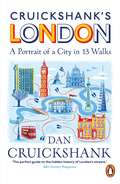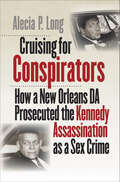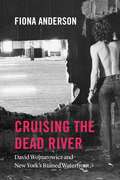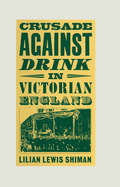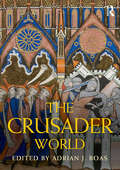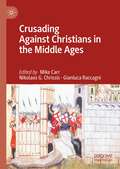- Table View
- List View
Cruickshank’s London: A Portrait Of A City In 20 Walks
by Dan CruickshankLondon. City of ancient churches and bustling markets, palatial townhouses and modest terraces, two millennia of expansion, commerce and street life. This is its story.In Cruickshank’s London, Britain’s favourite architectural historian offers a tour through thirteen districts that made London into London. From the mysterious Anglo-Saxon roots of Hampstead Heath, via Christopher Wren’s magisterial City churches, to the industrial bustle of Victorian Bermondsey, each of his walks explores a crucial site in our capital’s history – and reveals how it forged the modern capital.Jumping between East Ham in the east and Kew in the west, Dan Cruickshank explores both world-famous buildings (the Tower of London and St Pancras Station) and oft-overlooked local landmarks (Dagenham Civic Centre and Kensal Green Cemetery). His tales reveal not only the most important moments in London’s history, but also the forgotten characters who witnessed them: the Huguenot weavers who transformed Spitalfields into a vibrant enclave of Georgian London, the visionary architects behind the likes of Somerset House and the Houses of Parliament, and the streetwalkers who once thronged London’s great sexual highway. Along the way, he peppers the book with beautiful photographs, historical sketches and handy maps, so you can immediately follow in his footsteps.Above all, Cruickshank calls on you to explore London. Every street in the city contains a story. This book invites you to hear them.
Cruising for Conspirators: How a New Orleans DA Prosecuted the Kennedy Assassination as a Sex Crime (Boundless South)
by Alecia P. LongNew Orleans district attorney Jim Garrison's decision to arrest Clay Shaw on March 1, 1967, set off a chain of events that culminated in the only prosecution undertaken in the assassination of John F. Kennedy. In the decades since Garrison captured headlines with this high-profile legal spectacle, historians, conspiracy advocates, and Hollywood directors alike have fixated on how a New Orleans–based assassination conspiracy might have worked. Cruising for Conspirators settles the debate for good, conclusively showing that the Shaw prosecution was not based in fact but was a product of the criminal justice system's long-standing preoccupation with homosexuality. Tapping into the public's willingness to take seriously conspiratorial explanations of the Kennedy assassination, Garrison drew on the copious files the New Orleans police had accumulated as they surveilled, harassed, and arrested increasingly large numbers of gay men in the early 1960s. He blended unfounded accusations with homophobia to produce a salacious story of a New Orleans-based scheme to assassinate JFK that would become a national phenomenon. At once a dramatic courtroom narrative and a deeper meditation on the enduring power of homophobia, Cruising for Conspirators shows how the same dynamics that promoted Garrison's unjust prosecution continue to inform conspiratorial thinking to this day.
Cruising for Trouble: Cruise Ships as Soft Targets for Pirates, Terrorists, and Common Criminals
by Mark GaouetteThis book offers an alarming inside look at the security preparations of the cruise industry and the potential for cruise ships to be the target for pirates, terrorists, and criminal activity.Cruising for Trouble exposes the acute vulnerability of cruise ships to piracy, terrorism, and crime, both on the high seas and in domestic and foreign ports-of-call. While cruise ships have ramped up in size and passenger capacity to become floating skyscrapers housing as many as 7,000 passengers, and while piracy incidents have increased since 2008 as the world economy has deteriorated, there has been no corresponding increase or enhancement in onboard security personnel, external tactical units, preventive screening, or coordinated response planning to guard against the growing threat of acts of piracy and internal and external terrorist attacks. Commander Gaouette reveals to cruise passengers the very real security dangers they unwittingly face when they saunter up the gangway of a cruise ship for a carefree holiday. He sounds a clarion call to national and transnational security agencies, maritime regulators, legislators, and customers to compel the cruise industry to strengthen and reform its security programs before catastrophe strikes. The author, a longtime cruise industry insider who now serves as a top maritime security official in the Department of Homeland Security, details the many security defects and vulnerabilities of cruise ships, identifies the remedies, and makes the case for their urgent implementation. Extensively documented and illustrated, Cruising for Trouble is a vividly told cautionary for the ten million Americans who taken cruise-ship vacations each year and the millions more who would like to. As well as modeling the potential threats to cruise ships from pirates and maritime terrorists—who mimic each other's methods, overlap each other's territories, and might well find it mutually beneficial to combine their forces and resources—Commander Gaoutte recounts many actual examples of cruise-ship insecurity that have been swept under the carpet or spun by the cruise industry: pirate attacks, fires, onboard crime, mass food poisonings and infections, and the mysterious disappearances of cruise-ship passengers.
Cruising the Dead River: David Wojnarowicz and New York's Ruined Waterfront
by Fiona AndersonIn the 1970s, Manhattan’s west side waterfront was a forgotten zone of abandoned warehouses and piers. Though many saw only blight, the derelict neighborhood was alive with queer people forging new intimacies through cruising. Alongside the piers’ sexual and social worlds, artists produced work attesting to the radical transformations taking place in New York. Artist and writer David Wojnarowicz was right in the heart of it, documenting his experiences in journal entries, poems, photographs, films, and large-scale, site-specific projects. In Cruising the Dead River, Fiona Anderson draws on Wojnarowicz’s work to explore the key role the abandoned landscape played in this explosion of queer culture. Anderson examines how the riverfront’s ruined buildings assumed a powerful erotic role and gave the area a distinct identity. By telling the story of the piers as gentrification swept New York and before the AIDS crisis, Anderson unearths the buried histories of violence, regeneration, and LGBTQ activism that developed in and around the cruising scene.
Cruising the Dead River: David Wojnarowicz and New York's Ruined Waterfront
by Fiona AndersonIn the 1970s, Manhattan’s west side waterfront was a forgotten zone of abandoned warehouses and piers. Though many saw only blight, the derelict neighborhood was alive with queer people forging new intimacies through cruising. Alongside the piers’ sexual and social worlds, artists produced work attesting to the radical transformations taking place in New York. Artist and writer David Wojnarowicz was right in the heart of it, documenting his experiences in journal entries, poems, photographs, films, and large-scale, site-specific projects. In Cruising the Dead River, Fiona Anderson draws on Wojnarowicz’s work to explore the key role the abandoned landscape played in this explosion of queer culture. Anderson examines how the riverfront’s ruined buildings assumed a powerful erotic role and gave the area a distinct identity. By telling the story of the piers as gentrification swept New York and before the AIDS crisis, Anderson unearths the buried histories of violence, regeneration, and LGBTQ activism that developed in and around the cruising scene.
Cruising the Dead River: David Wojnarowicz and New York's Ruined Waterfront
by Fiona AndersonIn the 1970s, Manhattan’s west side waterfront was a forgotten zone of abandoned warehouses and piers. Though many saw only blight, the derelict neighborhood was alive with queer people forging new intimacies through cruising. Alongside the piers’ sexual and social worlds, artists produced work attesting to the radical transformations taking place in New York. Artist and writer David Wojnarowicz was right in the heart of it, documenting his experiences in journal entries, poems, photographs, films, and large-scale, site-specific projects. In Cruising the Dead River, Fiona Anderson draws on Wojnarowicz’s work to explore the key role the abandoned landscape played in this explosion of queer culture. Anderson examines how the riverfront’s ruined buildings assumed a powerful erotic role and gave the area a distinct identity. By telling the story of the piers as gentrification swept New York and before the AIDS crisis, Anderson unearths the buried histories of violence, regeneration, and LGBTQ activism that developed in and around the cruising scene.
Cruising the Dead River: David Wojnarowicz and New York's Ruined Waterfront
by Fiona AndersonIn the 1970s, Manhattan’s west side waterfront was a forgotten zone of abandoned warehouses and piers. Though many saw only blight, the derelict neighborhood was alive with queer people forging new intimacies through cruising. Alongside the piers’ sexual and social worlds, artists produced work attesting to the radical transformations taking place in New York. Artist and writer David Wojnarowicz was right in the heart of it, documenting his experiences in journal entries, poems, photographs, films, and large-scale, site-specific projects. In Cruising the Dead River, Fiona Anderson draws on Wojnarowicz’s work to explore the key role the abandoned landscape played in this explosion of queer culture. Anderson examines how the riverfront’s ruined buildings assumed a powerful erotic role and gave the area a distinct identity. By telling the story of the piers as gentrification swept New York and before the AIDS crisis, Anderson unearths the buried histories of violence, regeneration, and LGBTQ activism that developed in and around the cruising scene.
Cruising the Dead River: David Wojnarowicz and New York's Ruined Waterfront
by Fiona AndersonIn the 1970s, Manhattan’s west side waterfront was a forgotten zone of abandoned warehouses and piers. Though many saw only blight, the derelict neighborhood was alive with queer people forging new intimacies through cruising. Alongside the piers’ sexual and social worlds, artists produced work attesting to the radical transformations taking place in New York. Artist and writer David Wojnarowicz was right in the heart of it, documenting his experiences in journal entries, poems, photographs, films, and large-scale, site-specific projects. In Cruising the Dead River, Fiona Anderson draws on Wojnarowicz’s work to explore the key role the abandoned landscape played in this explosion of queer culture. Anderson examines how the riverfront’s ruined buildings assumed a powerful erotic role and gave the area a distinct identity. By telling the story of the piers as gentrification swept New York and before the AIDS crisis, Anderson unearths the buried histories of violence, regeneration, and LGBTQ activism that developed in and around the cruising scene.
Cruising the Dead River: David Wojnarowicz and New York's Ruined Waterfront
by Fiona AndersonIn the 1970s, Manhattan’s west side waterfront was a forgotten zone of abandoned warehouses and piers. Though many saw only blight, the derelict neighborhood was alive with queer people forging new intimacies through cruising. Alongside the piers’ sexual and social worlds, artists produced work attesting to the radical transformations taking place in New York. Artist and writer David Wojnarowicz was right in the heart of it, documenting his experiences in journal entries, poems, photographs, films, and large-scale, site-specific projects. In Cruising the Dead River, Fiona Anderson draws on Wojnarowicz’s work to explore the key role the abandoned landscape played in this explosion of queer culture. Anderson examines how the riverfront’s ruined buildings assumed a powerful erotic role and gave the area a distinct identity. By telling the story of the piers as gentrification swept New York and before the AIDS crisis, Anderson unearths the buried histories of violence, regeneration, and LGBTQ activism that developed in and around the cruising scene.
Crusade against Drink in Victorian England
by Lilian Lewis ShimanDrink, 'the curse of Britain', was sweeping the land, or so it seemed to many Englishmen in the early decades of the nineteenth century. They held it responsible for crime, poverty and many other ills of the rapidly industrializing towns. A 'moderation' temperance reform organized in 1829 largely under middle class auspices soon gave way to a radical commitment to total abstinence in a great variety of worker self-help groups. When these too failed to change the drinking habits of most Englishmen the temperance movement sought new alliances. In the 1870s and 1880s Gospel Temperance married temperance to revivalist religion. It received the support of both established and non-conformist churches, and millions 'took the pledge'. But many did not; and as religious enthusiasm faded the anti-drink forces shifted their attention to the political arena. After successfully pressuring the Liberal Party to adopt limited prohibition, they mounted a great but unsuccessful campaign in the 1895 election. With this defeat the anti-drink crusade disintegrated, leaving the dedicated teetotallers socially isolated in the safe haven of their drink-free subculture.
The Crusade Against Slavery: 1830-1860
by Louis FillerPerhaps no other crusade in the history of the U.S. provoked so much passion and fury as the struggle over slavery. Many of the problems that were a part of that great debate are still with us. Louis Filler has brought together much information both known and new on those who organized to defeat slavery. He has also re-examined the anti-slavery movement's ideals, heroes, and martyrs with historical perspective and precision. Contrary to popular belief, the anti-slavery movement was far from united. It included abolitionists as well as a variety of reformers whose activities place them among the anti-slavery forces. These included men as different in background and temperament as William Lloyd Garrison and John Quincy Adams. Portraits of the many protagonists, their hardships, and their quarrels with Southerners and Northerners alike, bring to life this exciting and tumultuous period. Filler also examines the many related reform movements that characterized the period: feminism, spiritualism, utopian societies, and educational reform. The volume traces the relationship of the antislavery movement to abolition and probes their connection with the several reforms that dominated the period. He brilliantly recaptures a sense of the contemporary consequences of the reformers efforts. This is an absorbing and important survey of the problems--political, social, and economic--that made this period so crucial in the history of the U.S.
The Crusade Against Slavery: 1830-1860
by Louis FillerPerhaps no other crusade in the history of the U.S. provoked so much passion and fury as the struggle over slavery. Many of the problems that were a part of that great debate are still with us. Louis Filler has brought together much information both known and new on those who organized to defeat slavery. He has also re-examined the anti-slavery movement's ideals, heroes, and martyrs with historical perspective and precision. Contrary to popular belief, the anti-slavery movement was far from united. It included abolitionists as well as a variety of reformers whose activities place them among the anti-slavery forces. These included men as different in background and temperament as William Lloyd Garrison and John Quincy Adams. Portraits of the many protagonists, their hardships, and their quarrels with Southerners and Northerners alike, bring to life this exciting and tumultuous period. Filler also examines the many related reform movements that characterized the period: feminism, spiritualism, utopian societies, and educational reform. The volume traces the relationship of the antislavery movement to abolition and probes their connection with the several reforms that dominated the period. He brilliantly recaptures a sense of the contemporary consequences of the reformers efforts. This is an absorbing and important survey of the problems--political, social, and economic--that made this period so crucial in the history of the U.S.
Crusade for Justice: The Autobiography of Ida B. Wells, Second Edition (Negro American Biographies and Autobiographies)
by Ida B. Wells“She fought a lonely and almost single-handed fight, with the single-mindedness of a crusader, long before men or women of any race entered the arena; and the measure of success she achieved goes far beyond the credit she has been given in the history of the country.”—Alfreda M. Duster Ida B. Wells is an American icon of truth telling. Born to slaves, she was a pioneer of investigative journalism, a crusader against lynching, and a tireless advocate for suffrage, both for women and for African Americans. She co-founded the NAACP, started the Alpha Suffrage Club in Chicago, and was a leader in the early civil rights movement, working alongside W. E. B. Du Bois, Madam C. J. Walker, Mary Church Terrell, Frederick Douglass, and Susan B. Anthony. This engaging memoir, originally published 1970, relates Wells’s private life as a mother as well as her public activities as a teacher, lecturer, and journalist in her fight for equality and justice. This updated edition includes a new foreword by Eve L. Ewing, new images, and a new afterword by Ida B. Wells’s great-granddaughter, Michelle Duster.
Crusade for Justice: The Autobiography of Ida B. Wells, Second Edition (Negro American Biographies and Autobiographies)
by Ida B. Wells“She fought a lonely and almost single-handed fight, with the single-mindedness of a crusader, long before men or women of any race entered the arena; and the measure of success she achieved goes far beyond the credit she has been given in the history of the country.”—Alfreda M. Duster Ida B. Wells is an American icon of truth telling. Born to slaves, she was a pioneer of investigative journalism, a crusader against lynching, and a tireless advocate for suffrage, both for women and for African Americans. She co-founded the NAACP, started the Alpha Suffrage Club in Chicago, and was a leader in the early civil rights movement, working alongside W. E. B. Du Bois, Madam C. J. Walker, Mary Church Terrell, Frederick Douglass, and Susan B. Anthony. This engaging memoir, originally published 1970, relates Wells’s private life as a mother as well as her public activities as a teacher, lecturer, and journalist in her fight for equality and justice. This updated edition includes a new foreword by Eve L. Ewing, new images, and a new afterword by Ida B. Wells’s great-granddaughter, Michelle Duster.
Crusade for Justice: The Autobiography of Ida B. Wells, Second Edition (Negro American Biographies and Autobiographies)
by Ida B. Wells“She fought a lonely and almost single-handed fight, with the single-mindedness of a crusader, long before men or women of any race entered the arena; and the measure of success she achieved goes far beyond the credit she has been given in the history of the country.”—Alfreda M. Duster Ida B. Wells is an American icon of truth telling. Born to slaves, she was a pioneer of investigative journalism, a crusader against lynching, and a tireless advocate for suffrage, both for women and for African Americans. She co-founded the NAACP, started the Alpha Suffrage Club in Chicago, and was a leader in the early civil rights movement, working alongside W. E. B. Du Bois, Madam C. J. Walker, Mary Church Terrell, Frederick Douglass, and Susan B. Anthony. This engaging memoir, originally published 1970, relates Wells’s private life as a mother as well as her public activities as a teacher, lecturer, and journalist in her fight for equality and justice. This updated edition includes a new foreword by Eve L. Ewing, new images, and a new afterword by Ida B. Wells’s great-granddaughter, Michelle Duster.
Crusade for Justice: The Autobiography of Ida B. Wells, Second Edition (Negro American Biographies and Autobiographies)
by Ida B. Wells“She fought a lonely and almost single-handed fight, with the single-mindedness of a crusader, long before men or women of any race entered the arena; and the measure of success she achieved goes far beyond the credit she has been given in the history of the country.”—Alfreda M. Duster Ida B. Wells is an American icon of truth telling. Born to slaves, she was a pioneer of investigative journalism, a crusader against lynching, and a tireless advocate for suffrage, both for women and for African Americans. She co-founded the NAACP, started the Alpha Suffrage Club in Chicago, and was a leader in the early civil rights movement, working alongside W. E. B. Du Bois, Madam C. J. Walker, Mary Church Terrell, Frederick Douglass, and Susan B. Anthony. This engaging memoir, originally published 1970, relates Wells’s private life as a mother as well as her public activities as a teacher, lecturer, and journalist in her fight for equality and justice. This updated edition includes a new foreword by Eve L. Ewing, new images, and a new afterword by Ida B. Wells’s great-granddaughter, Michelle Duster.
Crusader Archaeology: The Material Culture of the Latin East
by Adrian J BoasCrusader Archaeology examines what life was like for European settlers in the Latin East and how they were influenced by their new-found neighbours. Incorporating recent excavation results and the latest research, this new edition updates the only detailed study of the material culture of the Frankish settlers in Israel, Cyprus, Syria and Jordan. Adrian Boas provides comprehensive coverage of the key topics connected to crusader archaeology, including an examination of urban and rural settlements, agriculture, industry, the military, the church, public and private architecture, arts and crafts, leisure pursuits, death and burial and building techniques. There are also entirely new chapters on domestic architecture and disease, injury and medical treatment. Drawing on the extensive experience of an established writer in the field, Crusader Archaeology effectively combines a broad body of material to introduce readers to the archaeological research of the region. This well-illustrated volume is a crucial survey for all those interested in the Middle Ages, and in particular the Crusades.
Crusader Archaeology: The Material Culture of the Latin East
by Adrian J BoasCrusader Archaeology examines what life was like for European settlers in the Latin East and how they were influenced by their new-found neighbours. Incorporating recent excavation results and the latest research, this new edition updates the only detailed study of the material culture of the Frankish settlers in Israel, Cyprus, Syria and Jordan. Adrian Boas provides comprehensive coverage of the key topics connected to crusader archaeology, including an examination of urban and rural settlements, agriculture, industry, the military, the church, public and private architecture, arts and crafts, leisure pursuits, death and burial and building techniques. There are also entirely new chapters on domestic architecture and disease, injury and medical treatment. Drawing on the extensive experience of an established writer in the field, Crusader Archaeology effectively combines a broad body of material to introduce readers to the archaeological research of the region. This well-illustrated volume is a crucial survey for all those interested in the Middle Ages, and in particular the Crusades.
Crusader Archaeology: The Material Culture of the Latin East
by Adrian J. BoasThe third edition of Crusader Archaeology updates previous editions to include coverage of important recent work in the field. It examines what life was like for European settlers and travellers to the crusader states during the centuries of Latin rule.Examining past, recent and ongoing archaeological discoveries, and research in the field from Israel, Jordan, Syria, Turkey and Cyprus, this volume includes recent findings and approaches including new exploration work in urban sites such as Jerusalem, Acre and Caesarea, new work on industrial sites and new discoveries in research including DNA studies, the field of weaponry and many other topics. It covers such topics as settlement types, fortification, daily life, day-to-day activities, warfare, religious life, arts, industry, leisure pursuits, building technology, agriculture, medicine, death and burial. It considers, in all these fields, the manner in which the Frankish population was influenced by the local and neighbouring populations, and how, in many of their endeavours, the Franks evolved and developed their own, unique and often remarkably advanced material culture. Together with the archaeological evidence, Crusader Archaeology provides a historical background to the various topics in order to give context to each of the discussions. Crusader Archaeology remains the only comprehensive study of the architecture and material finds of the Crusader period.This well-illustrated volume serves as a basic textbook for students and scholars with an interest in the Middle Ages and in particular the Crusades and the Latin East.
Crusader Archaeology: The Material Culture of the Latin East
by Adrian J. BoasThe third edition of Crusader Archaeology updates previous editions to include coverage of important recent work in the field. It examines what life was like for European settlers and travellers to the crusader states during the centuries of Latin rule.Examining past, recent and ongoing archaeological discoveries, and research in the field from Israel, Jordan, Syria, Turkey and Cyprus, this volume includes recent findings and approaches including new exploration work in urban sites such as Jerusalem, Acre and Caesarea, new work on industrial sites and new discoveries in research including DNA studies, the field of weaponry and many other topics. It covers such topics as settlement types, fortification, daily life, day-to-day activities, warfare, religious life, arts, industry, leisure pursuits, building technology, agriculture, medicine, death and burial. It considers, in all these fields, the manner in which the Frankish population was influenced by the local and neighbouring populations, and how, in many of their endeavours, the Franks evolved and developed their own, unique and often remarkably advanced material culture. Together with the archaeological evidence, Crusader Archaeology provides a historical background to the various topics in order to give context to each of the discussions. Crusader Archaeology remains the only comprehensive study of the architecture and material finds of the Crusader period.This well-illustrated volume serves as a basic textbook for students and scholars with an interest in the Middle Ages and in particular the Crusades and the Latin East.
The Crusader World (Routledge Worlds)
by Adrian BoasThe Crusader World is a multidisciplinary survey of the current state of research in the field of crusader studies, an area of study which has become increasingly popular in recent years. In this volume Adrian Boas draws together an impressive range of academics, including work from renowned scholars as well as a number of though-provoking pieces from emerging researchers, in order to provide broad coverage of the major aspects of the period. This authoritative work will play an important role in the future direction of crusading studies. This volume enriches present knowledge of the crusades, addressing such wide-ranging subjects as: intelligence and espionage, gender issues, religious celebrations in crusader Jerusalem, political struggles in crusader Antioch, the archaeological study of battle sites and fortifications, diseases suffered by the crusaders, crusading in northern Europe and Spain and the impact of Crusader art. The relationship between Crusaders and Muslims, two distinct and in many way opposing cultures, is also examined in depth, including a discussion of how the Franks perceived their enemies. Arranged into eight thematic sections, The Crusader World considers many central issues as well as a large number of less familiar topics of the crusades, crusader society, history and culture. With over 100 photographs, line drawings and maps, this impressive collection of essays is a key resource for students and scholars alike.
The Crusader World (Routledge Worlds)
by Adrian J. BoasThe Crusader World is a multidisciplinary survey of the current state of research in the field of crusader studies, an area of study which has become increasingly popular in recent years. In this volume Adrian Boas draws together an impressive range of academics, including work from renowned scholars as well as a number of though-provoking pieces from emerging researchers, in order to provide broad coverage of the major aspects of the period. This authoritative work will play an important role in the future direction of crusading studies. This volume enriches present knowledge of the crusades, addressing such wide-ranging subjects as: intelligence and espionage, gender issues, religious celebrations in crusader Jerusalem, political struggles in crusader Antioch, the archaeological study of battle sites and fortifications, diseases suffered by the crusaders, crusading in northern Europe and Spain and the impact of Crusader art. The relationship between Crusaders and Muslims, two distinct and in many way opposing cultures, is also examined in depth, including a discussion of how the Franks perceived their enemies. Arranged into eight thematic sections, The Crusader World considers many central issues as well as a large number of less familiar topics of the crusades, crusader society, history and culture. With over 100 photographs, line drawings and maps, this impressive collection of essays is a key resource for students and scholars alike.
Crusading Against Christians in the Middle Ages
by Mike Carr Nikolaos G. Chrissis Gianluca RaccagniThis is the first book-length study into crusading against Christians, examining this complex phenomenon from the twelfth to fifteenth centuries and across numerous regions, from France to Russia and from southern Italy to the Baltic. Whilst the crusades are an immensely popular topic, those launched against Christian rulers and communities have been comparatively overlooked in the past, with existing studies typically focusing on a particular area, period, or campaign. This volume brings together the expertise of thirteen scholars on a variety of primary and secondary sources not often accessible to Anglophone readership, as well as their knowledge of national discourses which have often shaped historiography. It aims to serve as the first port of call for anyone who wishes to approach crusades against Christians within and without the specialism of crusader studies, and to provide the basis for a thorough comparative analysis of this phenomenon, covering its variety as comprehensively as possible.
Crushing the IT Gender Bias: Thriving as a Woman in Technology
by Kellyn Pot’Vin-GormanConscious and unconscious bias, societal pressures, and discomfort with women’s ambition are issues that women are confronted with in any male-dominated setting, and tech is no exception. Statistically, women are a disproportionately small percentage of the technology industry. How did we get here, what is changing, and what can future generations of women in STEM expect?In Crushing the IT Gender Bias, author Kellyn Pot’Vin-Gorman applies her two decades of experience in tech to these meaningful questions, plus many more. As a mentor and sponsor of women in the database and development communities, Pot’Vin-Gorman uses experience, visualizations of hard data, and industry interviews to describe the many challenges that women face in STEM. She then shows you how to inoculate against them. Small, positive changes like these are similar to a vaccine: they build individual immunity and thus create herd immunity to protect the most vulnerable. This shift is accomplished through increased representation of—and direct exposure to—successful role models in the industry.You’ll get practical advice related to hiring practices, salary negotiations, and barriers to collaboration. After witnessing multiple female peers depart the tech world, Pot’Vin-Gorman has written Crushing the IT Gender Bias to make her voice heard and to start this necessary conversation productively so that women can thrive. Additionally, this book is for male professionals who desire to grow in their understanding and eliminate bias in their environments.Do not be content with mere survival. Read this book, practice the techniques, and, most importantly, learn how to pay it forward. By arming yourself with knowledge and facing bias head-on, you can be the meaningful change that you want to see in the tech industry.Who This Book Is ForWomen in any area of technology with a desire to make and lead positive change by eliminating conscious and unconscious bias along with strategically confronting the many issues facing women in a field dominated by cultural bias. The book appeals to those just starting a career through to seasoned professionals, and even to those entering the management tier. This book also welcomes men with a desire to grow in their understanding and eliminate bias in the world around them.
Crusoe's Footprints: Cultural Studies in Britain and America
by Patrick Brantlinger"Cultural Studies" has emerged in British and American higher education as a movement that challenges the traditional humanities and social science disciplines. Influenced by the New Left, feminism, and poststructualist literary theory, cultural studies seeks to analyze everday life and the social construction of "subjectivities." Crusoe's Footprints encompasses the movement of many colleges and universities in the 1960s towards such interdisciplinary and "radical" programs as American Studies, Women's Studies, and Afro-American Studies. Brantlinger also examines the role of feminist criticism which has been particularly crucial in both Britain and the U.S.
